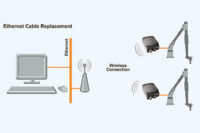In recent years, the term microelectromechanical systems (MEMS) has become synonymous with the reference to such low-cost sensors, generally implying the use of a micro-machined silicon structure as the heart of the sensing element. More recently, however, advances in ceramic processing and production have spawned a new generation of low-cost, low-power piezoelectric accelerometers. These devices rival most MEMS sensors in price, while offering a new range of performance choices for many industrial vibration monitoring applications.
Radio-linked
One such application gaining increasing interest is that of wireless integrated networking systems. This expanding and often complex radio-linked network of sensors, data acquisition and control systems embedded in critical equipment is expected to enable businesses to better monitor, control and manage their assets. By monitoring vibration characteristics related to tool chatter on a cutting machine, for example, factory personnel can tell when a tool is getting dull and needs to be changed -- before defective or out-of-specification product is produced. A wireless data acquisition control network can be used to collect, measure and transmit vibration data via a wireless link to a host personal computer, which displays the data in a user-defined format.
In a typical application, the user mounts accelerometers onto a piece of machinery at any number of critical points to be monitored. The individual sensors are then connected to modules or nodes, each of which incorporates a radio for wireless communication with a computer or handheld device. The node can operate from either an external power supply or an internal battery. The nominal transmission range for most devices used today is roughly 10 meters.
The node, which collects data from the multiple sensors and transmits it via a wireless network to a computer, can supply the excitation voltage to each sensor or, alternatively, an external source can be used as the excitation to the sensors. Each node is typically configured to handle multiple analog inputs and digital outputs. The application software accepts user setup commands, forwards them to the wireless networking system, time stamps the data and provides the user with a number of transmission and/or archival options.
One of the major advantages of wireless systems is the elimination of sensor wiring, which represents a major cost component for installations in which the channel count is large and where environmental conditions make access or maintenance difficult. Thus, substantial cost savings can be realized in the installation, set-up and support of wireless systems.
Communicating nodes
Several U.S. companies are currently developing wireless integrated networking systems. Rockwell Science Center (Thousand Oaks, CA), for example, has developed a wireless sensor product called HiDRA (Highly Deployable Remote Access), which is being marketed by a Rockwell spin-off company, Zone 5 Wireless Systems Inc. (Beverly Hills, CA).
The HiDRA system consists of a network of communicating nodes that can be placed on individual pieces of factory floor machinery. Each node, which measures 6 by 3.5 by 3 inches, connects to a variety of piezoelectric sensors used to detect vibration and temperature. The node also contains a processor to convert the raw sensor data into high-value information regarding machine performance, as well as a low-power radio for wireless transmission of the information to a processing or data collection center for display and evaluation.
The HiDRA system is already performing successfully in a number of industrial settings. According to Jim Duncan, executive vice president of business development for Zone 5 Wireless Systems, "The introduction of HiDRA will enable a wider use of wireless monitoring programs that can optimize the use of machinery, boost quality, lower manufacturing costs and improve plant efficiency."
Another company that has developed wireless networked systems is Invocon (Conroe, TX). One of Invocon's systems consists of multiple remote sensor units, a network control unit and a PC. Each remote sensor unit contains all the electronics needed for acquiring analog signals from sensors, amplifying and filtering those signals, converting the analog signals to digital, storing the digital data, processing the digital information for data reduction, and transmitting the data via the network to a central location.
Another Invocon system was developed for use on space structures that are under construction, and is currently being used to monitor critical temperatures during assembly of the International Space Station. But the system is equally suited for vibration and temperature monitoring in factory applications.
Piezoelectric accelerometers and a variety of other low-cost sensor types are critical components in these wireless networks, which are employed to ensure efficient operation of equipment and machinery in critical applications. As sensor technologies continue to advance, expect these low-cost devices to make possible a broadening range of industrial applications that were once considered cost-prohibitive.
TECH TIPS
- Wireless networks for industrial vibration monitoring can be economical, thanks to new low-cost, low-power piezoelectric accelerometers.
- Data from vibration sensors mounted on factory machines can be collected and transmitted wirelessly to a computer for analysis.
- By monitoring vibration characteristics on a cutting machine, factory personnel can tell when a tool is getting dull and needs to be changed, before defective product is produced.
- A major advantage of wireless networks is the elimination of sensor wiring, which is a big cost component for installations in which the channel count is large.

